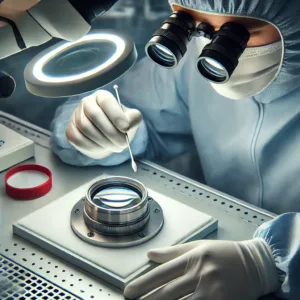In the production of LiDAR (Light Detection and Ranging) systems, the quality of the lens is crucial. A single particle or residue can significantly affect the performance and accuracy of the system. One of the most widely used tools for cleaning sensitive components like LiDAR lenses is the Gel Sticky Swab. However, while effective, there are some common challenges that may arise when using these cleaning swabs. In this article, we will explore potential problems, their causes, and the best solutions for optimal cleaning performance.

Potential Issues in LiDAR Lens Cleaning
When using Gel Sticky Swabs in the production of LiDAR lenses, the following issues may be encountered:
1. Generation of Micro Debris
During the cleaning process, users may notice small fragments or fibers being left on the lens surface after swabbing. These micro-debris can be problematic as they may degrade the performance of the LiDAR system.
Causes:
- Swab Quality: Low-quality cleaning swabs may shed particles, leaving debris behind.
- Static Electricity: Gel Sticky Swabs can accumulate static charges, attracting dust and tiny fibers, which could stick to the surface.
- Manufacturing Process: The cleaning process itself may contribute to generating these particles, especially if not executed under controlled conditions.
2. Streaks or Smudges on the Lens
Another issue users may encounter is the appearance of streaks or smudges after cleaning the lens with Gel Sticky Swabs. These marks can interfere with the clarity and precision of LiDAR measurements.
Causes:
- Excess Cleaning Gel: Using too much gel or not allowing the swab to properly absorb excess moisture may leave streaks.
- Improper Technique: Incorrect or uneven pressure while swabbing the lens can lead to streak formation.
- Environment: Contaminants or particles in the air (e.g., dust or humidity) can affect the cleaning results and contribute to smudges.
Solutions to Enhance Cleaning Results
To avoid these problems and ensure a high-quality cleaning process, consider the following solutions:
1. Opt for High-Quality Gel Sticky Swabs
The quality of the swabs directly affects cleaning efficiency. Premium Gel Sticky Swabs are designed to be more durable and less likely to shed fibers. They are made from materials that do not leave any residues behind and are engineered to minimize particle release.
- Solution: Always choose high-quality, industry-grade swabs designed specifically for sensitive electronics or optical lenses. Ensure they are manufactured with minimal shedding material.
2. Control Static Electricity
Static electricity can attract dust and cause particles to stick to the lens or the cleaning swab itself. To mitigate this, manufacturers can use anti-static swabs or implement anti-static equipment in the cleanroom environment.
- Solution: Use anti-static Gel Sticky Swabs and ensure your workspace is static-free. Anti-static wrist straps, mats, or ionizers can help prevent the accumulation of static charges.
3. Optimize Cleaning Process
To avoid streaks and smudges, it is essential to follow a well-defined cleaning process. Excessive gel or improper technique can leave unwanted marks on the lens.
- Solution:
- Use the correct amount of cleaning gel: Apply only a small amount, and ensure the swab is evenly coated.
- Proper swabbing technique: Swab in a circular motion to ensure an even and thorough clean.
- Cleanroom environment: Perform the cleaning in a dust-free, controlled environment to avoid introducing foreign particles onto the lens.
4. Implement Quality Control Checks
Frequent inspection of the lens post-cleaning is essential to ensure that no micro-debris or smudges remain. Regular checks during the production process help identify issues early and prevent them from affecting the final product.
- Solution: Establish a quality control procedure to inspect lenses at each stage of cleaning. Using magnification tools or microscopes can help detect any debris or imperfections left behind.
Conclusion
Gel Sticky Swabs are an essential tool in the delicate task of cleaning LiDAR lenses, but they must be used with care and attention to avoid common issues like micro-debris or streaks. By using high-quality swabs, controlling static, optimizing the cleaning technique, and implementing quality control checks, manufacturers can ensure that their LiDAR lenses remain spotless and perform at their highest potential.
By addressing these potential problems early on, you can enhance the cleaning process and maintain the integrity of your LiDAR systems.



